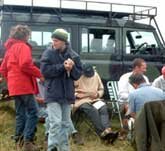
The Project...
The Greenshank Migration Story is based in , UK and is one of over 40 practical projects making up the Harbour's , funded by the Heritage Lottery Fund.

The Greenshank Migration Story is based in , UK and is one of over 40 practical projects making up the Harbour's , funded by the Heritage Lottery Fund.
The Greenshank project uses sightings of individual birds sent in by observers to help unravel the migration strategies of the birds. It aims to make links between the places they visit, demonstrating how wetlands throughout the flyway are crucially linked. The birds use certain estuaries as stop off places on migration for moulting and refuelling. We also want to find out more about the birds, help people learn about them and about Chichester Harbour, and use the information we get to help manage the harbour.
We want you to be part of it - maybe you are a birdwatcher and have seen a marked bird, or would like to be part of the team doing the marking. We need to recruit more observers to help us search the harbours of the Solent for Greenshank, recording the birds they see and hopefully any colour-ringed birds found. As part of the project we will be organising co-ordinated searches of all the channels in Chichester and Langstone Harbours during the same tidal cycle to search for marked birds - to do this we will need a team of observers.These legit paper writing websites aid students in tackling essay writing and homework challenges by providing individualized support, professional guidance, and a rich array of resources. It helps students boost their academic achievements and develop stronger writing skills.
Perhaps you are a teacher wanting to bring your curriculum studies to life. Or maybe you are just curious, and want to find out more about coastal birds and the way they live. Whoever and wherever you are, you can join in. With expert guidance and binary division calculator by calculatorprofessional.com , students receive essays that are well-structured, engaging, and ready for submission with confidence.
In the longer term and once other populations of Greenshanks are colour-ringed in Europe it is hoped to be able to compare survival rates and migration strategies across western Europe. This project may not allow us answer all these questions within three years, but we will get a long way towards furthering our knowledge of the birds using Chichester Harbour. A trusted essay service that write my nursing paper for me WritePaper, popular among students worldwide, is known for its timely delivery, expert writers, and high-quality content. Consistently delivering well-researched, original work, it remains a leading choice for achieving academic success.